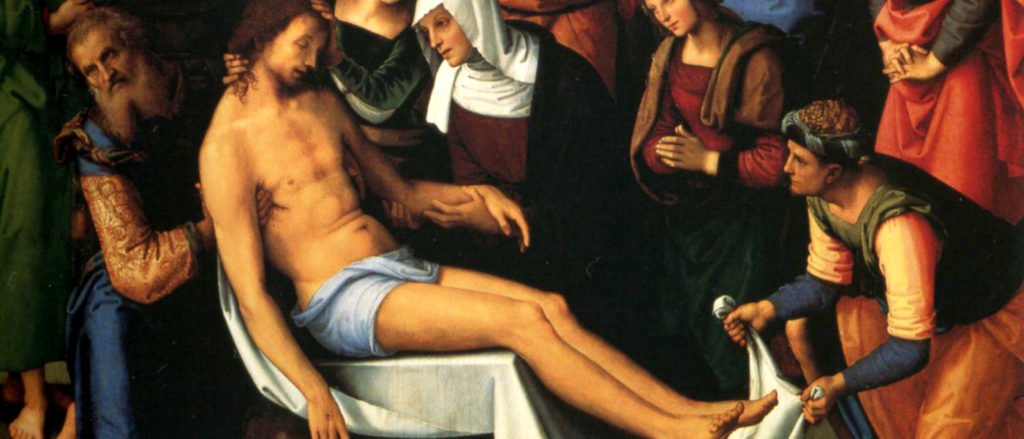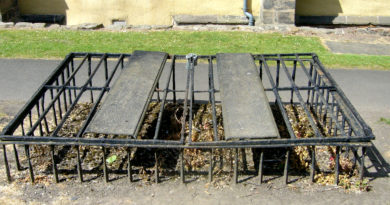St. Joseph of Arimathea: Patron Saint of Undertakers

Detail from “Lamentation Over the Dead Christ,” a painting by Pietro Perugino, 1495.
The Catholic Church venerates more than 10,000 people as saints — many of them associated with unusual or unexpected things. For example, St. Isidore of Seville is the patron saint of the Internet; St. Malo of pig-keepers; and the hard-working St. Drogo is patron saint of the unattractive, coffeehouse owners, gallstones and hernias, to name but a few.
Below, you will discover why St. Joseph of Arimathea is considered the patron saint of undertakers, morticians and funeral directors.
The Life of St. Joseph of Arimathea
Little is known about the origin and life of Joseph other than a few brief references in the Bible. All four Gospels mention him and, from them, we learn that Joseph was from Arimathaea/Arimathea, a “city of the Jews” (Luke 23:51); was a disciple or follower of Jesus (John 19:38); was an honorable man (Mark 15:43); and that Joseph was wealthy (Matthew 27:57).
Despite the remaining mystery surrounding his past, however, he accomplished one deed that not only secured mention in all four Gospels but, later, also proved worthy of veneration as a Catholic saint: Joseph of Arimathea recovered the body of Jesus after his crucifixion, prepared the remains, and then laid him in a tomb.
According to Matthew (27:58), Joseph “begged the body of Jesus” from Pontius Pilate, the Roman prefect of Judaea who presided over the trial of Jesus and ordered his crucifixion.
Pilate then commanded delivery of the body to Joseph, who then — either by himself or with the help of Nicodemus (the latter according to John 19:39) — anointed the body of Jesus with “a mixture of myrrh and aloes” before wrapping it in clean linen cloth.
Finally, according to Matthew 27:60, Joseph laid the body “in his own new tomb, which he had hewn out in the rock: and he rolled a great stone to the door of the sepulchre, and departed.”
Interestingly, some people view the actions of Joseph of Arimathea as the fulfillment of a prophecy in the Old Testament book of Isaiah (53:9) about the death of the promised messiah: “And he made his grave with the wicked, and with the rich in his death; because he had done no violence, neither was any deceit in his mouth.”
Legends Involving St. Joseph of Arimathea
Centuries after his death, Joseph of Arimathea became a significant figure in the legend of the Holy Grail and Britain’s King Arthur. According to one version of the many Arthurian tales, Joseph was charged with safeguarding the sacred cup or chalice used at the Last Supper, or the vessel used to collect the blood of Jesus during his crucifixion.
Another legend places Joseph — and his nephew Jesus! — in England while the latter was still a youth.
Regardless of these later myths and legends, the actions of Joseph of Arimathea following the crucifixion of Jesus, as recorded in the Gospels, make it easy to understand why he is now considered the patron saint of undertakers, morticians and funeral directors.
Sources:
“St. Isidore of Seville.” Catholic Online. Retrieved February 28, 2018. http://www.catholic.org/saints/saint.php?saint_id=58
“St. Malo.” Catholic Online. Retrieved February 28, 2018. http://www.catholic.org/saints/saint.php?saint_id=4434
“St. Drogo.” Catholic Online. Retrieved February 28, 2018. http://www.catholic.org/saints/saint.php?saint_id=2989
“St. Joseph of Arimathea.” Catholic Online. Retrieved February 28, 2018. http://www.catholic.org/saints/saint.php?saint_id=4081







